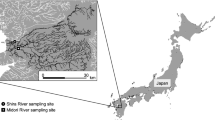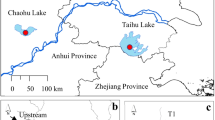Abstract.
In order to better understand the role of colloids in aquatic systems, better fractionation methods of environmental samples into particulate, colloidal, and truly dissolved phase are needed. An adequate fractionation procedure involves 1) prefiltration to remove large (i.e., settling) particles and 2) ultrafiltration to separate colloids from the truly dissolved compounds. Prefiltration is most commonly accomplished using filters with 0.45 or 0.22 μm pore size, which results in the inclusion of coarse colloids (size by definition up to about 1 μm) into the particulate phase. To evaluate the possible drawbacks of such operational procedures, the trace metal fraction associated with coarse colloids (size range 0.45-1.2 μm) was quantified in a number of rivers having different biogeochemical characteristics and degree of anthropogenic impact. Al, Pb, and Ti showed a strong association with coarse colloids (often over 50% of the total filterable metal at 1.2 μm) in all rivers. Other elements (Co, Cr, Cu, Fe, Mn, Ni, U, V, and Zn) had a more variable behaviour, possibly linked to differences in conductivity, oxygen saturation, and nature of colloids (mineral, organic, or mixed) among rivers. No overall statistically significant relationships could be found between the percentage metal fractions associated with coarse colloids and master environmental variables. However, when systems where classified according to the nature of colloids, Al and Pb showed statistically significant relationships with suspended particulate matter. Significant relationships were also observed between the metal pairs Mn/Co, Mn/Cu, Mn/V, Fe/Co, and Fe/Ni. The association of trace metals with coarse colloids has important implications as to their transport, fate and bioavailability in natural systems. These findings suggest that, at least in some cases, the use of the classical size limit of 0.45 μm as a boundary between the particulate and dissolved phases should be partially reconsidered and redefined.
Similar content being viewed by others
Author information
Authors and Affiliations
Additional information
Received: 16 October 2002; revised manuscript accepted: 21 March 2003
RID="*"
ID="*"Corresponding author pphone: +41 22 950 97 24; fax: +41 22 755 13 82; e-mail: davide.vignati@terre.unige.ch¶ Published on Web: July 3, 2003
Rights and permissions
About this article
Cite this article
Vignati, D., Dominik, J. The role of coarse colloids as a carrier phase for trace metals in riverine systems. Aquat. Sci. 65, 129–142 (2003). https://doi.org/10.1007/s00027-003-0640-2
Issue Date:
DOI: https://doi.org/10.1007/s00027-003-0640-2




